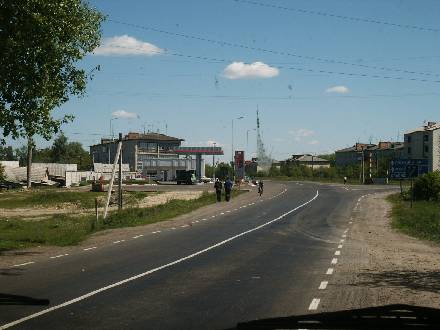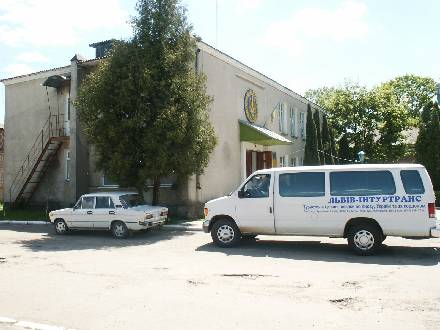Dear Andrew,
Enclosed is a disk with photos of Kolki (and a few of Luck/Lutsk). There is also a folder entitled "Jewish Sites." My travels took me to Kyiv, Lviv, Warsaw, and Berlin and in each place I visited some synagogues, cemeteries, and monuments. Although I am not at all religious, I found myself drawn to this heritage, and in some places I was profoundly moved. The documentation of the Warsaw Ghetto at the Jewish Historical Institute in Warsaw was simple yet so powerful I could not stay. I have included a few photos from some of these sites for your interest. Also included is a photocopy of two articles from the English-language Kyiv paper about anti-Semitic activities. Nothing ever changes, I guess.
To reach Kolki I was based in Lviv, the capital of Galicia in southwest Ukraine. I got to know a bit of the history of the region. Over the centuries, the area was alternately Ukrainian, Russian/Soviet, Polish, German, Austrian. Among other things, this means that the spelling of town names changes constantly. Aside from the inevitable anti-Semitism throughout history, the region also has a solid history of other forms of ethnic rivalries and violence. Most recently, the Soviets relocated many people from Ukraine and Poland trying to create more uniform ethnic groups. (At other times they tried to disperse the same groups to minimize nationalism.) The area of Galicia and Volhynia-the Pale of Settlement-had a prodigious Jewish population. Many towns and cities were 40-50% Jewish and a few even had Jewish majorities.
Lutsk, the capital of Volhynia, is about 175 km northeast of Lviv, and Kolki is another 50 km northeast of Lutsk. The Styr River, which runs through Kolki, continues to Lutsk, though the highway does not follow the winding river. The travel agency (Scope Tours in NJ which specializes in Ukraine travel) arranged for a car with driver and guide/translator for me. On Tuesday, June 1, I was met at the hotel at 8 AM. It was supposed to be the Toyota and driver that met me at the airport, but he had some sort of car trouble so we wound up traveling in a van with a different driver. My translator was Iryna-a woman of about 40 who normally led tours and did translating. She was very nice and enormously helpful. Though she had never been to the US, her English was excellent. The ride to Kolki was about 3 hours. I wanted to take pictures of everything along the way, but I could not keep asking the driver to stop or we never would have reached the town. So some pictures are taken through the windows of the van as we are driving and are thus blurred or "dirty."
The area between Lviv and Kolki is mostly flat farmland, not unlike driving through the Midwest. Volhynia has more water-ponds, marshes, streams and a few state forests, including one outside Kolki. A two lane road is the main highway connecting all the distantly scattered towns and cities. Mostly the road is in decent shape, but especially around villages it is badly potholed and uneven necessitating slow driving. We saw almost no private cars other than in Lutsk. There were some trucks and the occasional bus, people on old bicycles, and horse-drawn wagons. Many farm animals along the way, few of which seem fenced or tied. This could be the origin site of "why did the chicken cross the road?" At village crossroads there were often groups of people waiting for the dilapidated bus. I suppose they work in Lutsk or possibly some nearby factory.
When we reach Kolki it is marked by a sign on the road-just like the entrance to any town. I wanted it to be special-Kolki shouldn't be just one more stop along the road!

The road at this point is tree lined making it very attractive. But 100 meters further, as we enter the town, it is ugly Soviet-era industrial and residential buildings, some of which are abandoned or never completed. Very depressing.

The driver asks some workers where the center is. We drive a bit further down the road and it becomes somewhat more attractive. There is an old church, a cemetery, a few nicer buildings. We find the town hall-a nondescript two-story building at the center (the site of the pharmacy where your ancestor worked?).

(This photo also shows our van which reads: Lviv Intertrans.) But there are no shops or anything of the kind. We go in to meet the mayor (chairman), Sviatoslav Oleksandrovich Reykin. His office is on the second floor. His secretary asks us to wait. She is a young woman named Stoler. (I think. She gave me her address so I could send her a copy of the photo I took of her. While I can read printed Cyrillic, I'm not sure that I have read her handwriting correctly.) She is shy and cannot give us much information, other than that the town has 3,200 people. I ask about using the toilet. There is only an outhouse-no indoor plumbing.